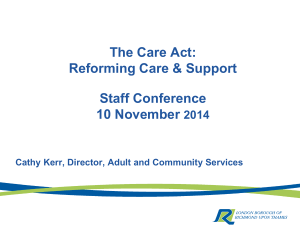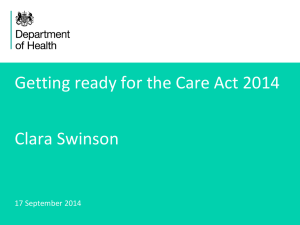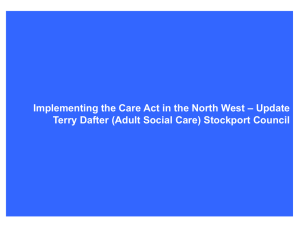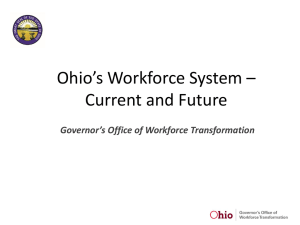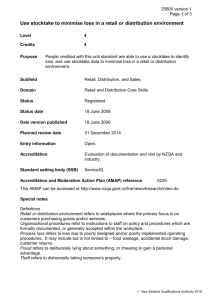Regional Perspectives on the Care Act 2014
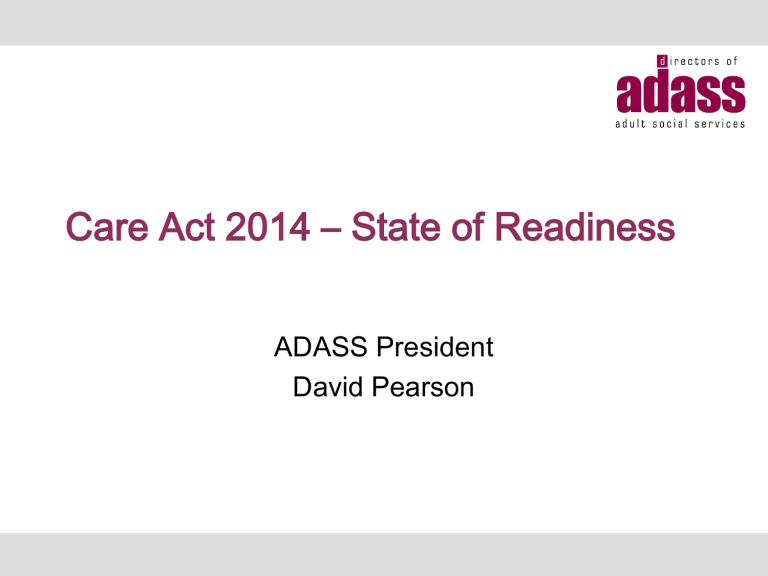
Care Act 2014 – State of Readiness
ADASS President
David Pearson
Purpose of the Care Act Session
• What does the review by the Major Projects Authority tell us about our work so far and the risks?
• What does the stocktake of Local Authorities tell us?
• Feedback from regions
• What are the areas of greatest risk and how are we tackling them?
• Detailed work on tables to assist with some of the high profile areas
Overview
• Care Act received Royal Assent on 14 th May 2014
• Very high degree of collaboration with amendments in the final stages of the bill and in drafting regulations and statutory guidance
• Widespread support for principles of health and wellbeing, personalisation, and co-commissioning / co-production
• The Act is a platform for the next few decades albeit in tough times
• Regulations and statutory guidance will shape the experience of the Act
Major Projects Authority
Project Assurance Review
• Independence of DH and the Programme Board
• Aim to identify the key threats to delivery of the Programme and help improve delivery confidence
• Scope both 16/16 and 16/17 implementation covering:
~ Policy, Business Context Programme delivery
~ The Summary case for change
~ Management of intended outcomes, and Stakeholder engagement
~ Approach to managing Risks and Issues
~ Readiness for the next stage
• Over 40 cross programme interviews over 5 days
MPA: Findings
Delivery Confidence Assessment
• 15/16 Amber
• 16/17 Amber/Red
“Strong commitment and support across system but inherent challenge and risk“
“Greater complexity & funding uncertainty”
•
Areas that are working well
‘A very strong tripartite relationship and joint programme office’ that should be protected
• Disparate policy initiatives pulled together in a single programme and coherent direction
• Consistent understanding of vision, objectives and main issues
• Energy within the programme
MPA: Findings
•
Areas of concern
“a major issue is funding” sufficiency and allocation mechanism
~ could threaten the strong collaborative approach to delivery
• Residual risks around workforce and informatics that are greater for the 16/17 deliverables
• The Programme would benefit from greater programme management rigour but not at expense of relationships
• 11 recommendations to strengthen the programme
Local Authority Stocktake (LAS)
Implementation Stocktake
• Developed and run by the PMO with sector input
• 100% response rate
• Focus on 9 proxy responses as an overall readiness indicator
~ More detail in full report, including regional analysis
• Traffic lights indicate where councils should be /progress at this stage
• Surveyed before regulations and guidance consultation began
• Report does not make recommendations
LA Stocktake: Findings
Programme Management & Governance
Q1 – Council has plan/programme to deliver the Care Act reforms
Yes: Complete No: Underway No: Not Started Don’t Know
36 63 1 0
Confidence
Q2 – How confident that the Care Act can be delivered
Very confident
36
Fairly confident
63
Not very confident
1
Not at all confident
0
Councils with 3 or more ‘red’ proxy indicators
17% have self-assessed as having slightly slower progress
LA Stocktake: Findings
Local preparedness
• On the whole a fair to good level of preparedness based on self-assessment with almost all having a plan in place
• Good level of awareness with local systems leaders
• Reasonably good progress in identifying people and carers who may have care and support needs
• Significant concerns around the costs of the reforms
• Workforce, informatics and communications are areas of concern
Major Projects Authority & Local
Authority Stocktake
Areas of Concern
• Both assurance exercises broadly highlighted the same
4 areas of concern:
~ Informatics
~ Workforce
~ Communications
~ Affordability
“Wicked issues” from the East
Midlands Region
• Self funders – Do we know enough about them and how to influence their behaviour?
• Information and advice – Some of what we are going to have to provide will be very specialist e.g. BSL, Easy Read, prisoners. Would national products be a good idea?
• Carers – Do we really know what demand to expect?
• Prevention – We need to prepare care managers to be able to provide a lot more information than they have done to date
• Financial impact – a lot of new responsibilities creep in almost under the radar, has the Impact Assessment really captured the costs of these?
• Workforce - “right sizing” the workforce when it is hard to precisely quantify the impact of the changes.
• Continuing Health Care and the Care Act
• Disabled Facilities Grants in two-tier council systems
“Wicked issues” from the
Eastern Region
• Unknown costs of implementing the reforms
• Additional carers’ assessments and personal budgets
• Readiness of ICT systems
• Workforce
• Communication strategy/plan/materials
• Public expectations
“Wicked issues” from the North East
Region
• The higher rates of deprivation and unemployment in the region in combination with low home ownership means a large percentage of people accessing social care would fall beneath the proposed £17,000 means tested threshold lower limit. This means that LAs would still be required to meet the vast majority of the full costs of care.
• The proposed ‘substantial’ eligibility criteria is more ‘generous’ than current offer from some
LAs in the region meaning a possible significant increase in numbers. The region already currently has the highest rates for people accessing ASC per 100,000 population.
• Identifying the numbers of potential self funders and carers who may be approaching local authorities for assessment.
• As a result of low property prices many people in the North East would still lose the full value of their property even with the £72k care cap. The lower care costs in the region would also mean many people would not benefit from the £72k cap.
•Significant additional responsibilities – market management, advice and assistance to those not eligible – without appropriate levels of funding at a time when social care is already under considerable pressure
“wicked issues” from the North West
Region (1)
In the NW a Task & Finish Group is scoping and preparing. Over 40 members have volunteered to participate (not all attend every meeting). Two sessions have identified that we want to:
• Share information and analysis undertaken individually or in groups
• Highlight good practice
• Encourage collaboration and lead roles to reduce duplication
• Communicate the ‘must-do’s’
• Make recommendations about the improvement play deployment of resources including the NW grant allocation
• Liaise and feed back information with LGA and DH named individuals
• Method for identifying self-funders. Local authorities can be broadly aware of self-funders in residential care, but less clear for those in non-residential care. Clarity on how to identify unknown demand without additional resource and within a reducing budget.
• Method for identifying the local costs of implementation in 15/16. There are concerns that the allocation for the new duties will be underestimated.
“wicked issues” from the North West
Region (2)
• The daily living cost if still set at £12k per year will have an impact locally – given that the NW have lower residential fee rates. We understand that there will be a new funding formula – and only the care element of the residential fee rate will be covered.
• Establish additional demand from carers – given a good NW network to help scope.
• Method identifying the numbers of deferred payment agreements that will be required and how existing arrangements (workforce, IT and finance systems) can meet these.
• Providing programme management guidance/resources. Request for a clear breakdown of activity at the national – regional – sub-regional tiers with local
‘must do’s’ to avoid duplication.
• Sharing information and good practice – to potentially manage demand
• IT support systems – understanding what is required and the software companies’ responses
• Prisons. We have a number of large prisons in the NW and the impact is not yet clear.
“Wicked issues” from the South East Region
• Governance and programme management - in place for counties, much less developed in UAs, need for additional resource
• Number of self funders estimated or advanced progress by counties.
UAs report moderate/early progress – some not yet started
• Less progress with estimating carers’ assessments
• Cost modelling underway – half of UAs just started /not done any work
• Engagement with key groups about the Care Act has hardly started
• Workforce reviews have started - no development plans in place
• Greatest risk - total implementation cost and funding, as well as additional demand for assessment
Summary
• Assessment is positive about tripartite arrangement.
• MPA and LA Stocktake consistent on areas of risk and no surprise to programme board.
• Regulations and Statutory guidance need full participation to improve .
• 16/17 paying for care costs still subject to discussions about the gap in assessment of costs with PSSRU support.
• Further work needed on carers and workforce to assure progress and reduce risk.
ADASS Business Unit
Local Government House
Smith Square
London SW1P 3HZ
Tel: 020 7072 7433
Fax: 020 7863 9133
EMAIL: team@adass.org.uk
WEB: www.adass.org.uk

